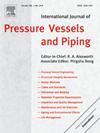Estimation of ultimate tensile strength of tubular materials using Ring Hoop Tension Test with cylindrical pins
IF 3.5
2区 工程技术
Q2 ENGINEERING, MECHANICAL
International Journal of Pressure Vessels and Piping
Pub Date : 2025-07-11
DOI:10.1016/j.ijpvp.2025.105598
引用次数: 0
Abstract
Mechanical characterization of metallic pipes is essential for assessing their structural integrity in industrial applications. The Ring Hoop Tension Test (RHTT) offers a simpler alternative to traditional methods for determining hoop strength, with two primary variants: the D-shaped pin configuration, which requires custom tooling for each pipe geometry, and the cylindrical pin system, which simplifies testing but introduces bending stresses. While the cylindrical pin method reduces friction-related uncertainties, its applicability for estimating ultimate tensile strength (UTS) had not been explored. This study develops a correlation between the minimum slope of the RHTT load–displacement curve and UTS in the hoop direction, specifically for cylindrical pins.
A dual approach combining finite element analysis (FEA) and experimental validation was employed. Numerical simulations examined the influence of pipe slenderness, pin diameter, and strain-hardening behavior, leading to an empirical model. Experimental tests on aluminum 6061-T6 pipes confirmed the method’s accuracy, with deviations below 3 % compared to standard tensile tests. The results highlight the impact of geometric factors, particularly the diameter-to-thickness ratio, and introduce a pin-size correction factor to refine the methodology. This work demonstrates that RHTT with cylindrical pins can effectively estimate UTS, offering a practical and reliable alternative to conventional methods.
用圆柱销环箍拉伸试验估计管状材料的极限抗拉强度
在工业应用中,金属管道的力学特性对评估其结构完整性至关重要。环箍张力测试(RHTT)提供了一种比传统方法更简单的箍箍强度测试方法,主要有两种变体:d形销配置,需要针对每种管道的几何形状定制工具,以及圆柱形销系统,简化了测试,但会引入弯曲应力。虽然圆柱销法减少了与摩擦相关的不确定性,但其在估计极限抗拉强度(UTS)方面的适用性尚未得到探讨。本研究开发了RHTT荷载-位移曲线的最小斜率与环向UTS之间的相关性,特别是对于圆柱形销。采用有限元分析与实验验证相结合的双重方法。数值模拟研究了管道长细比、销径和应变硬化行为的影响,并建立了经验模型。对6061-T6铝管的实验测试证实了该方法的准确性,与标准拉伸试验相比,偏差低于3%。结果强调了几何因素的影响,特别是直径与厚度比,并引入了针脚尺寸校正因子来改进方法。这项工作表明,带有圆柱引脚的RHTT可以有效地估计UTS,为传统方法提供了实用可靠的替代方案。
本文章由计算机程序翻译,如有差异,请以英文原文为准。
求助全文
约1分钟内获得全文
求助全文
来源期刊
CiteScore
5.30
自引率
13.30%
发文量
208
审稿时长
17 months
期刊介绍:
Pressure vessel engineering technology is of importance in many branches of industry. This journal publishes the latest research results and related information on all its associated aspects, with particular emphasis on the structural integrity assessment, maintenance and life extension of pressurised process engineering plants.
The anticipated coverage of the International Journal of Pressure Vessels and Piping ranges from simple mass-produced pressure vessels to large custom-built vessels and tanks. Pressure vessels technology is a developing field, and contributions on the following topics will therefore be welcome:
• Pressure vessel engineering
• Structural integrity assessment
• Design methods
• Codes and standards
• Fabrication and welding
• Materials properties requirements
• Inspection and quality management
• Maintenance and life extension
• Ageing and environmental effects
• Life management
Of particular importance are papers covering aspects of significant practical application which could lead to major improvements in economy, reliability and useful life. While most accepted papers represent the results of original applied research, critical reviews of topical interest by world-leading experts will also appear from time to time.
International Journal of Pressure Vessels and Piping is indispensable reading for engineering professionals involved in the energy, petrochemicals, process plant, transport, aerospace and related industries; for manufacturers of pressure vessels and ancillary equipment; and for academics pursuing research in these areas.

 求助内容:
求助内容: 应助结果提醒方式:
应助结果提醒方式:


